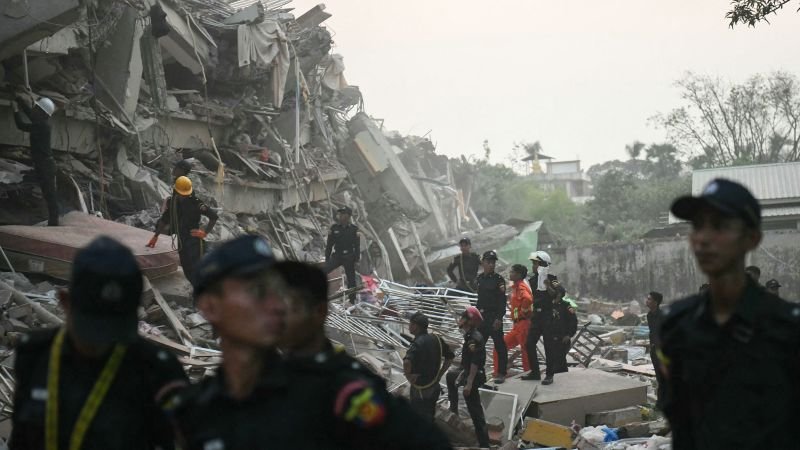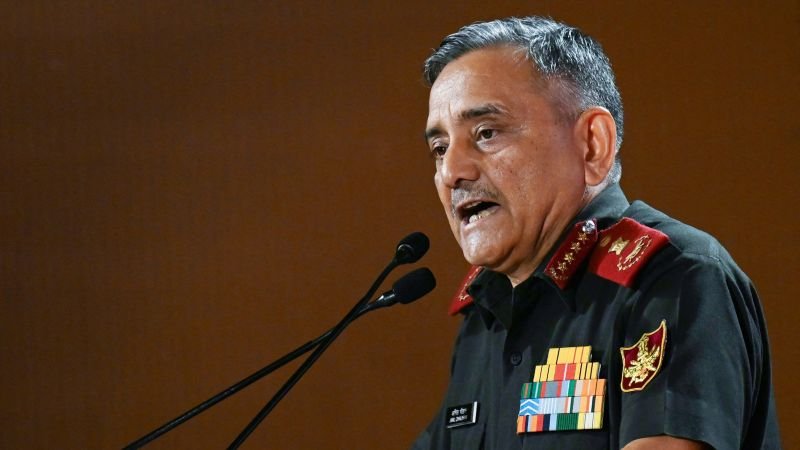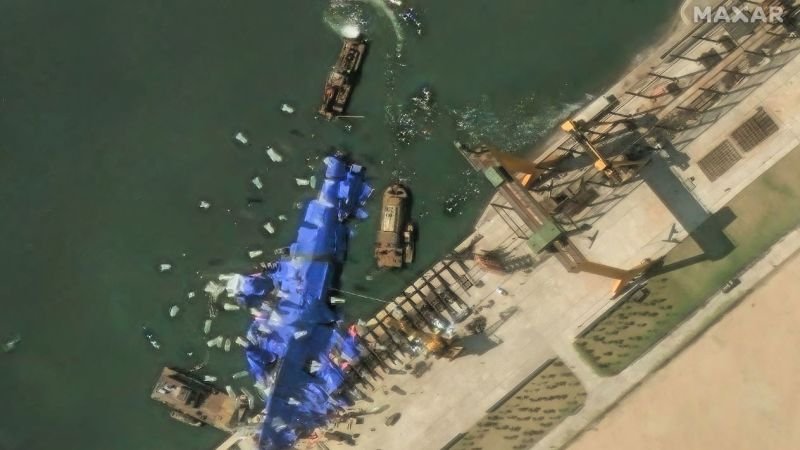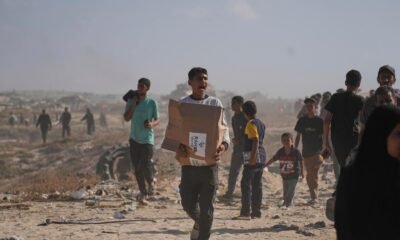CNN
—
Rescuers are desperately searching for survivors more than two days after a powerful 7.7-magnitude earthquake struck Myanmar, toppling buildings as far away as the Thai capital Bangkok and sending tremors through nearby Chinese provinces.
More than 1,600 people are dead after what was the largest earthquake to hit the war-ravaged country in more than a century, authorities say. Experts fear the true death toll could take weeks to emerge.
Widespread damage has been reported after the quake triggered bridges and buildings to collapse, including in Bangkok, where authorities are trying to free dozens believed to be trapped under the rubble of an under-construction high-rise.
The epicenter was recorded in Myanmar’s central Sagaing region, near the former royal capital Mandalay, home to around 1.5 million people, as well as multiple historic temple complexes and palaces.
Meanwhile, foreign aid and international rescue teams have started arriving in Myanmar after the military issued a rare plea for help.
Friday’s quake was the deadliest natural disaster to hit the country in years and comes as Myanmar reels from a civil war that since 2021 has damaged communication networks, battered health infrastructure and left millions without adequate food and shelter.
Here’s what we know.

More than 1,600 people are dead and around 3,400 injured, Myanmar’s military said on state television. Nearly 140 others remain missing.
Authorities expect that number to rise. The United States Geological Survey (USGS) estimated the final death toll could surpass 10,000 people, according to early modeling.
In Bangkok, hundreds of miles from the epicenter, at least 17 people were killed. Of these, 10 died when an under-construction building collapsed in minutes, leaving dozens trapped under the rubble. Seven fatalities were reported elsewhere in the capital, authorities said.
Search and rescue operations are ongoing in Bangkok for at least 80 people who remain missing, as families gather at the site of the collapsed high-rise for any news of their loved ones.
Around 9,500 reports of building damage have been received in Bangkok, the city’s governor said Sunday. Other than the collapsed tower, there have been few reports or evidence of catastrophic damage.
The earthquake was the most powerful to strike Myanmar in over a century, after it was struck by a 7.9-magnitude temblor in 1912 in Taunggyi, a city also in central Myanmar.
Aftershocks, the largest of which was a 6.7-magnitude tremor on Friday, have continued throughout the weekend, according to the USGS.
Deadly earthquake strikes Myanmar, Thailand and China
Testimonies and satellite images of the devastation have begun to emerge as witnesses in Myanmar recall the moments friends and loved ones were buried by rubble.
“It hit very strong and very fast,” one woman living in Mandalay recalled. Part of the wall of the house collapsed onto the woman’s grandmother who was sitting nearby, burying her legs in rubble and debris, she said.
A former lawyer in the city also told CNN that three members of his wife’s family had been killed in the quake. “Until now, we have not been able to recover their dead bodies from rubble,” he said.
The quake also shattered some of the city’s mosques, which were busy with worshippers attending Friday prayers, one man said.
Since the quake struck, communication has been difficult with people in Myanmar, including Mandalay – making it hard to know the true extent of the damage.
In the south, the townships of Nyaungshwe, Kalaw and Pinlaung are among the hardest hit by the earthquake, the United Nations’ Office for the Coordination of Humanitarian Affairs (OCHA) said.
“Thousands of people are spending the nights on the streets or (in) open spaces due to the damage and destruction to homes or fearing further quakes,” the agency said.
In Naypyidaw, the country’s military capital and 160 miles south of Mandalay, a three-story hospital partially collapsed, trapping patients beneath the rubble, Chinese state media said. Some 40 hours after the quake, China’s rescue team rescued one person from the debris.
As of Sunday, nearly 1,700 houses, 670 monasteries, 60 schools and three bridges were reported to be damaged, and there are concerns for the structural integrity of large dams, OCHA said. It also noted damage to hospitals, major bridges, universities and historical and public buildings.
Before-and-after satellite images released by Maxar Technologies show the scope of the damage, with multiple monasteries, temples, pagodas and buildings throughout Mandalay and Sagaing having severe structural damage.
The Sagaing Bridge over the mighty Irrawaddy River, which separates Sagaing and Mandalay, was destroyed, with nearly every section of the bridge fully or partially collapsed into the water.

Several countries have deployed resources to assist in rescue and relief operations after military leaders, normally averse to foreign involvement, issued a rare plea for help.
A team from China was the first to reach Myanmar’s biggest city Yangon on Saturday, China’s state broadcaster CCTV said, as Beijing pledged $13.8 million in humanitarian assistance.
Russia was quick to follow China in deploying its own team of specialists, including dog teams, anesthesiologists and psychologists, the country’s Emergencies Ministry said.
The United Kingdom, Ireland and Australia will donate aid packages totaling over $20 million in humanitarian assistance.
United States President Donald Trump described the quake as “terrible” and vowed that the US would also send assistance. India, Singapore, Malaysia and Hong Kong have also announced they would send help.
The UN announced an immediate pledge of $5 million in aid for Myanmar and said it was mobilizing teams and support for the relief effort.
However, rescue teams face a daunting task after infrastructure weakened by the civil war was further damaged by the quake. Efforts are also likely to be complicated as the quake’s impact zone includes areas that have seen intense fighting since the junta seized power in 2021 and where competing administrations – the military government and rebel groups – operate separately.
Aid groups say wrecked roads, rubble and communication blackouts are impeding relief efforts, according to the United Nations, as health authorities struggle to cope in a system also hollowed out by conflict.
Severe shortages of medical supplies – including trauma kits, blood bags, anesthetics and assistive devices – have complicated relief efforts, OCHA said Saturday.
Health workers on the ground are struggling to field streams of injured people, according to OCHA.

Myanmar is on an active earthquake belt, but many of the temblors usually happen in sparsely populated areas, not cities like those affected Friday.
The USGS and Germany’s GFZ center for geosciences said the earthquake was a shallow 10 kilometers (6.2 miles). Shallower earthquakes tend to cause more damage.
The energy released by it was the equivalent of 334 atomic bombs, a geologist told CNN, warning that aftershocks could be felt for months.
Scientists say the quake occurred along the Sagaing fault, which runs north-south through Myanmar, and that it is a “strike-slip” fault, when two tectonic plates shift mostly horizontally.
Brian Baptie, seismologist with the British Geological Survey, said the rupture moved the earth five meters (16.4 feet) over about a minute in some areas.
Because most of the buildings in the area are made from “timber or unreinforced brick masonry,” he said, they are highly vulnerable to quake damage.

































